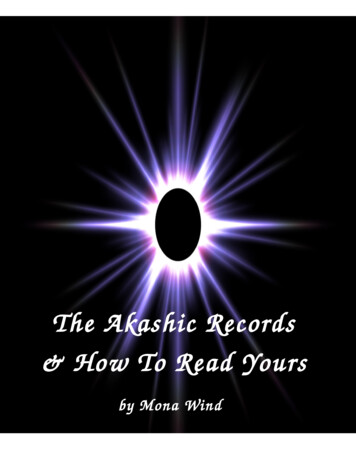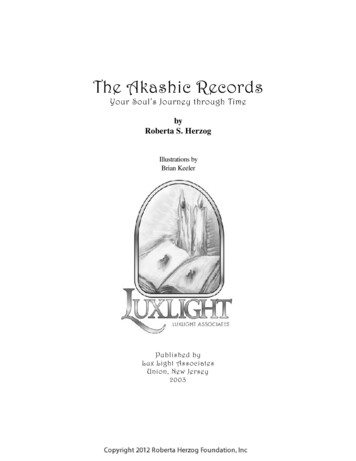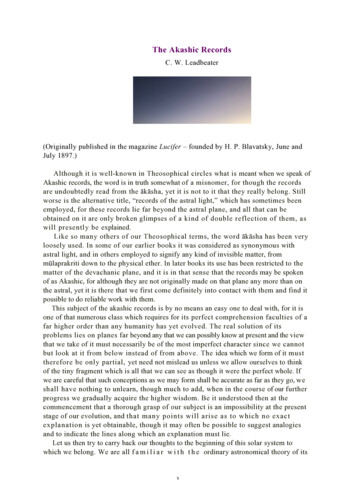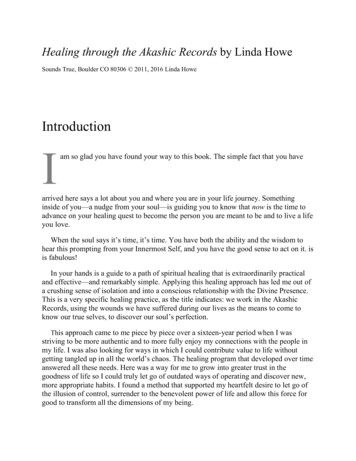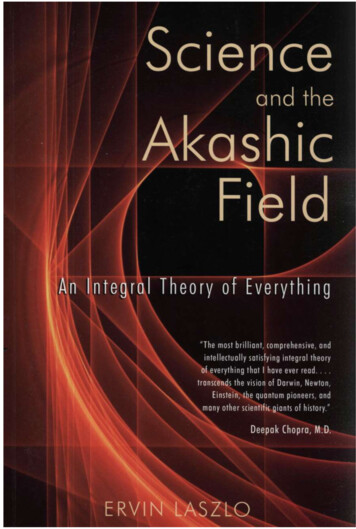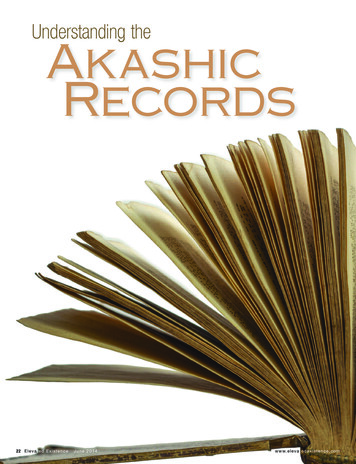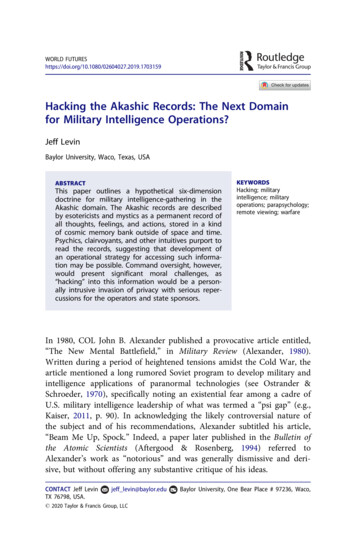
Transcription
WORLD 59Hacking the Akashic Records: The Next Domainfor Military Intelligence Operations?Jeff LevinBaylor University, Waco, Texas, USAKEYWORDSABSTRACTThis paper outlines a hypothetical six-dimensiondoctrine for military intelligence-gathering in theAkashic domain. The Akashic records are describedby esotericists and mystics as a permanent record ofall thoughts, feelings, and actions, stored in a kindof cosmic memory bank outside of space and time.Psychics, clairvoyants, and other intuitives purport toread the records, suggesting that development ofan operational strategy for accessing such information may be possible. Command oversight, however,would present significant moral challenges, as“hacking” into this information would be a personally intrusive invasion of privacy with serious repercussions for the operators and state sponsors.Hacking; militaryintelligence; militaryoperations; parapsychology;remote viewing; warfareIn 1980, COL John B. Alexander published a provocative article entitled,“The New Mental Battlefield,” in Military Review (Alexander, 1980).Written during a period of heightened tensions amidst the Cold War, thearticle mentioned a long rumored Soviet program to develop military andintelligence applications of paranormal technologies (see Ostrander &Schroeder, 1970), specifically noting an existential fear among a cadre ofU.S. military intelligence leadership of what was termed a “psi gap” (e.g.,Kaiser, 2011, p. 90). In acknowledging the likely controversial nature ofthe subject and of his recommendations, Alexander subtitled his article,“Beam Me Up, Spock.” Indeed, a paper later published in the Bulletin ofthe Atomic Scientists (Aftergood & Rosenberg, 1994) referred toAlexander’s work as “notorious” and was generally dismissive and derisive, but without offering any substantive critique of his ideas.CONTACT Jeff LevinTX 76798, USA.jeff levin@baylor.eduß 2020 Taylor & Francis Group, LLCBaylor University, One Bear Place # 97236, Waco,
2JEFF LEVINIn the 40 years since, several books and articles have gone into greatdepth on features of U.S. government and military operations whichsought functional capabilities in the paranormal realm. These includeprojects involving the CIA, DIA, NSA, and military intelligence branchesincluding INSCOM (e.g., Dames & Newman, 2010; Kress, 1999;Mandelbaum, 2000; Morehouse, 1996; Schnabel, 2011). Conspiracy magazines have weighed in with sensational claims about secretive projectsinvolving remote viewing, or psychic spying (e.g., Bekkum, 2012;Dowbenko, 1997). More scholarly documentation confirms that, whatevertheir objectives and outcomes, such programs indeed existed (e.g.,LoMeo, 2016; Srinivasan, 2002), part of a larger programmatic effort bythe military to validate methods to enhance human performance, whichformal evaluative research, such as undertaken by the National ResearchCouncil, later dismissed as mostly unproven (see Swets & Bjork, 1990).Projects undertaken from the 1970s to 1990s, such as Star Gate (and itspredecessors), were the subject of considerable controversy, and the literatureis replete with critiques and counter-critiques (see, e.g., Hyman, 1995; May,1996; Utts, 1995). Also published were books for popular audiences, such as amemoir of one noted U.S. Army “psychic spy” (McMoneagle, 2002; seereview by Broughton, 2003) and an assessment of the reality of “psychicwarfare” (White, 1988; see review by Jones, 1989). Subsequent toCongressionally mandated evaluation, conflicting results among validationstudies were instrumental in the program’s shuttering in 1995 (see Kennedy,2003). Detailed histories of these efforts can be found elsewhere (e.g., Benack,n.d.; Bremseth, 2001; Marrs, 2007; May, 2014; Puthoff, 1996).Notwithstanding the contentious, checkered, and disputed history of psychicspying in the U.S., notable intelligence failures in the war on terrorism(Lewis, 2004) coupled with the likelihood that such failures may be inevitable(Betts, 1978) argue against excluding any possibilities for information-gathering, no matter their perceived marginality, such as regarding psi. Acceleratingchallenges faced by current U.S. military cyber warriors, especially the unpredictability and diffuse threat posed by enemy combatants among both foreigngovernments and non-governmental players (Garamone, 2015), suggest thatit may be worthwhile to revisit these controversial ideas.Not so long ago, cyber/information was introduced as a new paradigmfor a military accustomed to a four-dimension land-sea-air-space doctrine. Accordingly, cyber would seem to be the ultimate domain of warfare operations. After transitioning from the physical planet (land andsea) to the atmosphere (air) and beyond (space), the virtual informationdomain (cyber) must presumably be the final frontier. This five-dimension doctrine has been operational for a quarter of a century (seeFogelman, 1995), and is a cutting edge of the U.S. military’s strategicplans moving forward (Card & Rogers, 2012; Department of Defense,
WORLD FUTURES32015). But, according to the publications cited above, perhaps it is timeto consider a sixth domain of operations.In the present paper, material is presented which cautiously reviewsthe possibility of a post-cyber domain for intelligence operations, foundedon the esoteric concept of the Akashic records—a repository of information and sensory/thought impressions “located” in the nonphysical realmsakin to Jung’s collective unconscious—thus moving quite beyond the present five-dimension doctrine. A new doctrine, made operational, woulddraw on human resources that would seem to surpass current consensusdefinitions of human capabilities, and would interface with (meta-)physical realities that would seem to surpass current consensus definitions ofphysical reality. An Akashic domain for military intelligence would thusrepresent a substantial expansion of the concept of battlespace to includea “dimension” that is located, apparently, outside of space—and time—asconventionally understood.Former DIRNSA, Commander of USCYBERCOM, and Chief of theCentral Security Service, ADM Michael S. Rogers, in advocating for ahighly trained, innovative, multi-sector Cyber Mission Force, has stated:Improving security for all and achieving cyber resilience takes a broad andcoordinated effort with unprecedented degrees of joint, interagency,coalition, and public-private sector collaboration. We need sustainedinteraction, exchanges of ideas, and regular exercises that bring the militaryand civilian cyber communities together across government, industry, andacademia to share information, coordinate planning, exercise, andbrainstorm together. (Rogers, 2015)The present paper endorses the same approach, but applied to a hypothetical next domain beyond cyber, the Akashic domain.The Akashic RecordsThe Akashic records are defined by esotericists and mystics as a permanent record of all of the thoughts, feelings, and actions that have everoccurred in the history of the universe (Bacheman, 1973; Gaynor, 1953),stored in “a kind of cosmic memory bank” (Watson, 1991, p. 6) thatexists outside of physical reality. This concept originates in the Sanskritword ak a sa (“the ether”), and has been described as a “field” accessiblepsychically and via spiritual practice (Laszlo, 2007). First introduced tothe West by 19th-century Theosophists, the concept of an Akashicrecords has become “part of the lingua franca of contemporary New-Agespirituality” (Levin, 2019).According to contemporary descriptions, ak a sa has nonlocal characteristics, in the sense of Dossey’s (2009) descriptions of nonlocal consciousness (see also Takhmazyan, 2013). The Secret Doctrine states that it
4JEFF LEVIN“pervades all things” (Blavatsky, 1970, p. I.334), and Laszlo (2007, p. 76)describes it as “an all-encompassing medium that underlies all things andbecomes all things.” It has also been described as “a kind of unified fieldof everything” (Levin, 2019). Most importantly, for the present paper, theAkashic records are also said to contain “information that comes fromthe external world without having been conveyed by the body’s exteroceptive senses” (Laszlo, 2009, p. 243). Information contained in therecords is thus presumably accessible primarily (solely?) through employing a psychic channel or trance medium or through intuitive self-readings. Typically, the records are accessed for purposes of spiritual growth,self-actualization, or healing—of the self or of others (see Trine, 2010).Operationally, the normative access point to the records tends toresemble a psychic reading session:Akashic readings are typically one-on-one sessions like other psychicreadings, and the channeler or medium may enter into a trance state oroperate from waking consciousness. Some practitioners believe that readingthe Akashic substrate can be taught for self-application, like other psicapabilities. Indeed, one could contend that psychic readings are readingsof the ak a sa implicitly—that they are one and the same thing.(Levin, 2019)Are the Akashic records real? This is a tricky question to answer, butone that ought to be addressed before we go any further. The answer tothat question depends in part on one’s scientific perspective and on whatone considers evidence of “reality.” Like other phenomena that are saidto exist in the nonphysical realms (e.g., the paranormal, the spirit world),skeptics typically demur, often disparagingly (e.g., Berard, 2000). This isnot unexpected, given the parameters of the materialist worldview (see,e.g., Sheldrake, 2012). On the other hand, numerous wisdom traditionsdo acknowledge the existence of the Akashic records, by that name or anequivalent, including Theosophy (Leadbeater, 1903), Anthroposophy(Steiner, 1911), Hinduism (Vivekananda, 1953), Buddhism (Sinnett,1883), Rosicrucianism (AMORC, 1961), Western esotericism (Cicero &Cicero, 2004), shamanism (Combs, Arcari, & Krippner, 2006), and theworks of Cayce (Todeschi, 1998) and Tesla (Pokazanyeva, 2016). Thesereferences cannot prove the existence of the Akashic records, of course,to everyone’s satisfaction. But the validation of psi phenomena and certain nonphysical realities by many scientists who have studied such thingswere instrumental, in part, in previous military- and intelligence-relatedexplorations of similar subjects (see Kress, 1977). The revisiting of theseefforts is advocated here, no matter the ethereal nature of such phenomena in the eyes of mainstream Western physical science and the“dilemmas” that they present to researchers (see Grof, 2006).
WORLD FUTURES5An article in Cyber Defense Review described cyberspace as “dynamicand uncertain” (Duggan, 2016, p. 78), recognizing that cyber is “botheverywhere and nowhere at the same time” (p. 73). The same could besaid of the Akashic domain, but even moreso. This is not to say that reliable and valid information-gathering from this domain is impossible—just that such readings may involve presumptions, skillsets, and technologies—and risks—uniquely distinct from engagement of the other fivedimensions of the current doctrine. Empirical validation of prior psirelated projects in military and intelligence circles—notwithstanding theirattendant controversies—coupled with findings from the scholarly literature on parapsychology together suggest that forays in the Akashicrealm are not inconceivable. An organized effort would, however, requirea distinctive set of operational parameters, including development of newprotocols. A skeleton outline for such a hypothetical program is provided here.Operational Parameters of an Akashic Intelligence DomainUnlike much of conventional remote reviewing, Akashic readings may bemore suited to reading the mind and consciousness of enemy targets andclairvoyantly viewing the future behavior and collective action of suchindividuals. The targets would not be military installations, geographic orgeological features, or other natural or man-made structures, but ratherthe psyche and life course of persons of interest. The operational objectives would involve understanding targets’ presumptions and motivationsand discerning their likely decision-making calculus and future (and past)actions. Engaging in such readings and tasking subordinates to do sowould, for sure, be considerably more complex than conventional behavioral profiling, involving a much more invasive probe of the personalspace of one’s targets. Such tasking may potentially present moral redflags cautioning against the use and misuse of information gleaned fromAkashic readings that were intended for strategic and tactical purposes(more on this later).The recommendations that follow are modeled, in part, after theDoD’s 2015 cyber strategy (Department of Defense, 2015). A few strategicgoals are provided, followed by selected implementation objectives. Itshould be understood that this material is drafted in broad strokes, by anacademic scientist outside of the loop. This template can be developedfurther, with details filled in by individuals with command authority andgreater content expertise. With these caveats in mind, basic requirementsof an Akashic intelligence-gathering program may be constructed aroundthe following goals and objectives.
6JEFF LEVINStrategic Goal I: Recruit and maintain a ready force and build capabilities to conduct Akashic-reading operations. This should include (a)recruiting and maintaining an Akashic workforce, through establishing apersistent training environment, creating job titles and/or career paths forpersonnel involved in performing and supporting operations, and identifying civilian technical personnel; (b) building technical capabilities forAkashic operations, through accelerating research and development,including with private-sector partners; and (c) testing and continuallyrefining a command and control mechanism for Akashic operations,especially so that it fun
The Akashic records are defined by esotericists and mystics as a perman-ent record of all of the thoughts, feelings, and actions that have ever occurred in the history of the universe (Bacheman, 1973; Gaynor, 1953), stored in “a kind of cosmic memory bank” (Watson, 1991, p. 6) that exists outside of physical reality. This concept originates in the Sanskrit word akasa (“the ether”), and .
